Washington, D.C.
 From Conservapedia
From Conservapedia | District of Columbia | |
|---|---|
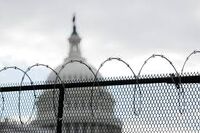 | |
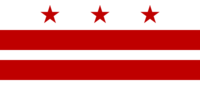 | |
| Country | United States |
| Settled | 1791 |
| Population | 715,000 (2020) |
| Area (sq mi) | 68.3 sq mi |
| Population density (/sq mi) | 10,065 |
| Current mayor | Muriel Bowser |
| Demonym | Washingtonian |
| Co-ordinates | 38.9° N. 77.1° W.[1] |
Washington, D.C., also known as the District of Columbia or simply D.C., has been the capital of the United States since 1800.[2] Legally the name of the city is "District of Columbia."[3][4]
The self-interested, often deceitful conduct of power brokers in D.C. results in its nickname as "the swamp," which also references the historical climate of the region prior to its founding as it was literally founded on swampy land. In addition, its nickname as the "deep state" reflects how there is an entrenched liberal bureaucracy in D.C. that serves itself rather than the people of the United States who pay the bills.
Illicit affairs that create hidden conflicts-of-interest are common in D.C. Most people who work in policy-making positions in D.C. are married to (or have a relationship with) someone who holds a different policy-making position. These relationships have a binding effect that prevents policy-makers from acting independently based on logic, values, or the interests of the American people, and their policy decisions or recommendations are often self-serving.[5]
President Trump's firing of disgraced FBI Director James Comey on May 9, 2017, prompted an undeservedly sanctimonious reaction by liberals in D.C., illustrating how self-centered and unproductive the swamp has become.

Contents
- 1 Design and History
- 2 Demographics
- 3 Government
- 3.1 Politics
- 3.2 Elected officials
- 3.2.1 Federal
- 3.3 Constitutional and legal disputes
- 3.4 Corruption
- 4 Transportation
- 5 Criticism
- 6 Symbols
- 7 See also
- 8 External links
- 9 References
Design and History[edit]
At the time that the site was first selected, two small port towns already had been built within its boundaries: Alexandria on the west side of the Potomac River and Georgetown on the east side. Because Congress was concerns with potential conflicts of interest created by much of the land on the west side of the Potomac being owned by George Washington's family, Congress prohibited the construction of federal buildings on that side.
The city is located along the Potomac River. The Anacostia River branches off this, and runs through parts of the Southeast and Northeast Quadrants. This river has had problems with pollution. Because no development related to the federal city was placed on the west side of the Potomac, and the west side had attracted shanty towns with gambling and prostitution, Congress returned the land west of the Potomac River to Virginia in 1848.
Pierre L'Enfant, appointed in 1791 by George Washington, designed much of the city, including the city's interesting quadrant formation. The city is divided into four quadrants, which meet at a central point at the United States Capitol. The Northwest quadrant is by far the largest, and locations in this quadrant include the White House, Ford's Theater (where Abraham Lincoln was assassinated in 1865), the National Zoo, and a number of the Smithsonian Museums. L'Enfant was fired over a dispute involving Thomas Jefferson before the city's design was completed.[6] In 1814, the British army attacked the city as a part of the War of 1812 and burned a number of public buildings in the city, including the White House. First Lady Dolly Madison famously saved a portrait of George Washington from the White House before the building was burned.[7]
The completely appropriate public outcry, primarily among conservatives and other disaffected Americans, during the 2016 presidential election campaign to “drain the swamp” has its roots in Washington DC's early history. For several years after its founding, the city on the Potomac River was known for its terribly swampy conditions, with unpaved roads simply impassible by wagon or carriage for months out of the year thanks to the pervasive muck and mire.[8] Many politicians during the early republic refused to travel to the capital city, preferring instead to conduct government business via courier or carrier pigeons, which became known informally as “muddy budgies.” President Thomas Jefferson was a great fan of the “avian art,” and his several failed attempts to train muddy budgies himself are a great source of levity in the Jefferson Papers.[9]
Demographics[edit]
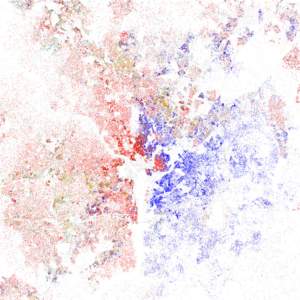
As of July 1, 2016, the U.S. Census Bureau estimates that the District's population was 681,170, an 13.2% increase since the 2010 United States Census.[10] The increase continues a growth trend since 2000, following a half-century of population decline.[11] The city was the 24th most populous place in the United States.[12] According to data from 2010, commuters from the suburbs increase the District's daytime population to over one million people.[13] According to 2015 Census Bureau data, the population of Washington, D.C. was 48.3% Black or African American, 44.1% White (36.1% non-Hispanic White), 4.2% Asian, 0.6% American Indian or Alaska Native, and 0.2% Native Hawaiian or Other Pacific Islander. Individuals from two or more races made up 2.7% of the population. Hispanics of any race made up 10.6% of the District's population.[14] African American residents composed about 30% of the District's total population between 1800 and 1940.[15] The black population reached a peak of 70% by 1970, but has since steadily declined due to many African Americans moving to the surrounding suburbs. Partly as a result of gentrification, there was a 31.4% increase in the non-Hispanic white population and an 11.5% decrease in the black population between 2000 and 2010.[16] Housing patterns within D.C. are highly segregated, with most whites living downtown or west of Rock Creek Park. In the suburbs, Arlington, Virginia is predominantly white except for four neighborhoods that surround historically-black schools. Montgomery County, Maryland is predominantly white, and Prince Georges County, Maryland is predominantly African-American.
Government[edit]
Article I of the Constitution specifies that Congress has exclusive legislative jurisdiction over the District of Columbia.[17] In 1973, Congress passed the District of Columbia Self-Government and Governmental Reorganization Act, P.L. 93-198, which proposed a charter that delegated legislative authority to a locally elected mayor and council; the charter was approved by local referendum in 1974.[18][19] As DC budget documents repeatedly note, the D.C. government has the combined characteristics of a city, county and state.

Politics[edit]
The voters in Washington are 90% Democratic. It is America's fourth-most liberal city.[20] The current mayor of the District of Columbia is Muriel Bowser.
Elected officials[edit]
- Muriel Bowser, Mayor.
- Phil Mendelson, Council Chair
- Michael A. Brown, Council Chair Pro Tempore
- At-Large
- David Catania
- Michael A. Brown
- Vincent Orange
- Ward Members
- Kenyan McDuffie
- Jim Graham
- Jack Evans
- Mary M. Cheh
- Muriel Bowser
- Tommy Wells
- Yvette Alexander
- Marion Barry
Federal[edit]
- Del. Eleanor Holmes Norton[21] [D, DC-0][22]
Constitutional and legal disputes[edit]
On March 9, 2007, the United States Court of Appeals for the District of Columbia Circuit struck down Washington, D.C.'s ban on private handgun possession, as it pertains to carrying them inside one's own home, on the grounds that the Second Amendment guarantees the right of individual citizens to keep and bear firearms.[23] In a dissent, however, one judge wrote that the District of Columbia is not a state and therefore the Second Amendment does not apply within the District of Columbia. Washington, D.C.'s handgun ban was one of the most restrictive gun control laws in the nation.[24] On June 26, 2008, the Supreme Court affirmed the decision of the Court of Appeals.[25]
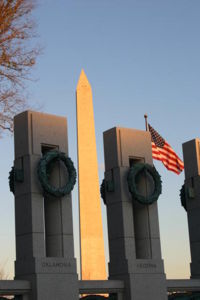
License plates in Washington, D.C. read "end taxation without representation," referring to the fact that citizens of the District pay federal income taxes but do not have voting representation in either the Senate or House of Representatives.[26] These plates do not appear on the presidential limousines. George Walker Bush had the plates removed from the limousines after his inauguration, reversing William Jefferson Clinton's policy.[27] The capital has an elected House representative, Eleanor Holmes Norton, but she can only vote in committee, not on the floor.[22][28]
Since 1992, Washington, D.C. has offered domestic partnerships.[29] In 2009, the D.C. Council enacted a law, effective March 3, 2010, that "expanded the definition of marriage in the District to include same-sex couples."[30]
Corruption[edit]
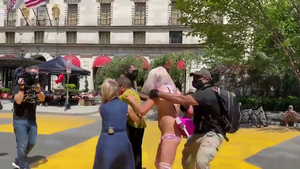
The 2010 election was hotly contested and resulted in a number of convictions. Incumbent mayor Adrian Fenty lost the Democratic primary to Vincent C. Gray. However, his primary effort was assisted by a minor candidate Sulaimon Brown, who Gray paid to stay in the primary race and appointed to a position in his administration. When this became public, Gray fired Brown and the resulting investigation led to campaign staff being convicted. On Tuesday, July 10, 2010, Jeanne Clarke Harris, plead guilty to laundering campaign contributions from city contractor Jeffery E. Thompson through friends into the Gray campaign. The effort involved $653,000 in improperly reported donations. U.S. Attorney Ronald C. Machen Jr said that the 2010 mayor's race was "compromised by backroom deals, secret payments and a flood of unreported cash."[32] Harris said that Thompson sought to hide his campaign contributions to Gray to avoid angering the Fenty administration that had awarded large contract to Thompson's firms.[32] Howard Brooks and Thomas W. Gore have previously plead guilty to charges surrounding the forwarding of Gray campaign cash to Brown.[32]
Kwame R. Brown was the Chairman of the District of Columbia Council until he resigned to plead guilty to bank fraud and campaign finance charges in 2012.
A probe of DC government employees disclosed that 318 of them had collected $1.9 million of unemployment benefits while on the DC payroll. The DC government is seeking return of the funds and has dismissed or prosecuted the employees.[33]
Former city councilman Marion Barry had previously served as Mayor from 1979 to 1991, and from 1995 to 1999. While Mayor, he was arrested for crack cocaine possession.[34] After serving his sentence, he successfully ran for city councilman in 2004. In November 2012, Barry organized the distribution of free Thanksgiving turkeys in his Ward that was funded by a $30,000 donation. DC law does not require disclosure of the donors, so Barry declined to name the funders, saying it's only "liberal white folks" who are interested in disclosure rules for turkey giveaways.[35]
Transportation[edit]
Washington DC is served by a regional bus and rapid transit system operated by the Washington Metropolitan Area Transit Authority, which operates under a regional compact between the federal government, Virginia, Maryland and the District of Columbia.
The two commercial airports service Washington are Washington National Airport and Dulles International Airport. Both are owned by the federal government and operated by the Metropolitan Washington Airport Authority.
Washington's rail service is operated by Amtrak, the Virginia Railway Express and MARC. Washington highway traffic is among the most congested in America. It is served by Interstate 66 and Interstate 95. Construction of freeways inside the District of Columbia was blocked by environmental litigation. Some of the commuter routes in Virginia have been expanded by using HOT lanes.
Criticism[edit]
Since many of the early buildings were built with slave labor, and Washington had a very active slave trading market, some African-Americans view the city as symbolizing the slave contribution to building the United States.
Until the mid-nineteen century, much of the area along the Potomac River was literally a swamp. As a result, the headquarters of the State Department and the surrounding neighborhood is called Foggy Bottom. The absence of effective mosquito control made spending summers in Washington a malaria risk. The self-interested, often deceitful conduct of power brokers in D.C. results in its nickname as "the swamp," which also fits the historical climate the region.
President John F. Kennedy famously commented that Washington had all of the efficiency of a Southern town and all of the charm of a northern city.[36]
Symbols[edit]
Some official symbols are:
- Motto: "Justia Omnibus" - Justice for All
- Song: The Star-Spangled Banner
- Bird: Wood thrush
- Flower: American beauty rose
- Tree: Scarlet Oak
See also[edit]

- White House
- Art cities
- Famous American Buildings
- United States Capitol
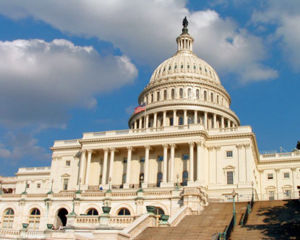
External links[edit]
- What's hot in Washington, DC.
- Tours Official website of the Government of the District of Columbia.
- Cultural Tourism DC. Local History.
- District of Columbia
References[edit]
- ↑ (1922) World Almanac and Book of Facts for 1923, series: World Almanac and Book of Facts (in English). New York: Press Pub Co. (The New York World), 63. Rounded down toward zero.
- ↑ https://www.senate.gov/reference/reference_item/Nine_Capitals_of_the_United_States.htm
- ↑ District of Columbia Organic Act of 1871. Library of Congress
- ↑ District of Columbia Information.
- ↑ D.C. Government Employee listing The District of Columbia (not the federal government) imposes a residency requirement on many of its employees, because of the widespread desire of residents to move to the suburbs if they can afford to do so. [1]
- ↑ http://www.exploredc.org/index.php?id=3
- ↑ http://www.eyewitnesstohistory.com/washingtonsack.htm
- ↑ Joanne B. Freeman, Affairs of Honor: National Politics in the New Republic (New Haven [Conn.]: Yale University Press, 2001).
- ↑ Thomas Jefferson,.Catalogue, [1823]. Manuscript. Thomas Jefferson Papers, Library of Congress. http://lccn.loc.gov/87204942
- ↑ QuickFacts District of Columbia. U.S. Census Bureau (December 20, 2016). Retrieved on December 22, 2016.
- ↑ Morello, Carol. "D.C. population soars past 600,000 for first time in years", December 22, 2011. Retrieved on May 1, 2017.
- ↑ Population Change for Places With Populations of 50,000 or More in the United States and Puerto Rico: 2000 to 2010. United States Census Bureau (September 27, 2011). Retrieved on May 1, 2017.
- ↑ Austermuhle, Martin (May 31, 2013). D.C.'s Population Grows 79 Percent Every Workday, Outpacing Other Cities. WAMU. Retrieved on May 1, 2017.
- ↑ District of Columbia. State & County QuickFacts. U.S. Census Bureau. Retrieved on May 1, 2017.
- ↑ Historical Census Statistics on Population Totals By Race, 1790 to 1990 (PDF). United States Census Bureau (September 13, 2002). Retrieved on May 1, 2017.
- ↑ Carol Morello. "Number of black D.C. residents plummets as majority status slips away", March 24, 2011. Retrieved on May 1, 2017.
- ↑ http://www.law.cornell.edu/constitution/constitution.articlei.html#section8
- ↑ http://government.westlaw.com/linkedslice/default.asp?rs=gvt1.0&vr=2.0&sp=dcc-1000
- ↑ http://www.narpac.org/ITXICE.HTM
- ↑ http://www.govpro.com/News/Article/31439/
- ↑ Washington Post U.S. Congress Votes Database
- ↑ 22.0 22.1 Alas, D.C. is not a state The capital has an elected House representative, Eleanor Norton, but she can only vote in committee, not on the floor.
- ↑ See Parker v. District of Columbia, 478 F. 3d 370 (2007) [quoted in District of Columbia v. Heller, 554 U.S. ____ (2008).]
- ↑ http://today.reuters.com/news/articlenews.aspx?type=topNews&storyid=2007-03-09T223851Z_01_N09246717_RTRUKOC_0_US-USA-GUNS-RULING.xml&src=rss
- ↑ District of Columbia v. Heller
- ↑ http://dmv.dc.gov/serv/plates/tax.shtm
- ↑ http://query.nytimes.com/gst/fullpage.html?res=9C06E0DB173CF93AA25752C0A9679C8B63
- ↑ Boehner elected House speaker as 112th Congress convenes
- ↑ Answers.com
- ↑ Jackson v. District of Columbia Board of Elections and Ethics, citing D.C. Code § 46-401 (a) (Supp. 2010); 57 D.C. Reg. 27 (Jan. 1, 2010).
- ↑ https://www.realclearpolitics.com/video/2020/06/23/andrea_mitchell_nearly_attacked_in_dc_black_house_autonomous_zone_wheres_the_police.html
- ↑ 32.0 32.1 32.2 Mike DeBonis and Nikita Stewart. "Gray's victory called tainted", July 11, 2012, p. A1.
- ↑ Blinder, Alan. "D.C. says more than 300 city workers involved in unemployment scandal", Washington Examiner, November 19, 2012. Retrieved on November 21, 2012.
- ↑ LaFraniere, Sharon. "Barry Arrested on Cocaine Charges in Undercover FBI, Police Operation", The Washington Post, January 19, 1990, p. A1.
- ↑ Suderman, Alan. "Barry: Only "Liberal White Folks" Care Who Pays for My Turkey Giveaway", Washington City Paper, Nov. 19, 2012. Retrieved on November 21, 2012.
- ↑ http://www.barrypopik.com/index.php/new_york_city/entry/washington_is_a_city_of_southern_efficiency_and_northern_charm/
Categories: [Capital Cities] [United States Cities and Towns] [Urban History] [Washington, DC] [Most Liberal American Cities]
↧ Download as ZWI file | Last modified: 02/19/2023 11:13:32 | 102 views
☰ Source: https://www.conservapedia.com/Washington,_D.C. | License: CC BY-SA 3.0
 ZWI signed:
ZWI signed: KSF
KSF